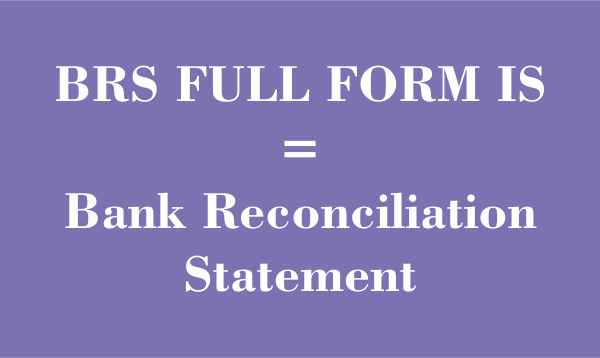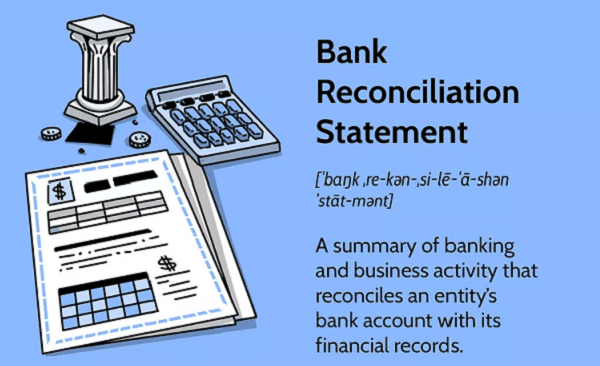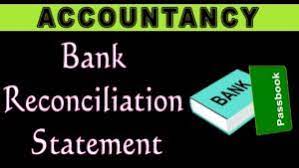What is the full form of BRSBRS: Bank Reconciliation StatementBRS stands for Bank Reconciliation Statement. A bank reconciliation statement is a document that assesses the agreement between an organization's accounting records and bank statements. In this article, we will go through the function of a bank reconciliation statement, its essential elements, and how to create one. Follow this procedure to preserve correct financial records and avoid fraud, mistakes, and other irregularities. 
Bank Reconciliation Statement's PurposeA company's records must match those of its bank for accurate financial reporting, which is the principal goal of a bank reconciliation statement. Sometimes differences exist between the bank statement and the company's records, such as improper bank charges, company record mistakes, or fraudulent activity. In that case, these can be found by comparing the two. A bank reconciliation statement lets businesses keep tabs on their account balances and cash movement. Small firms, which must carefully manage their finances and ensure they have enough cash to cover bills, should pay particular attention. Bank Reconciliation Statement's ComponentsThe following elements are frequently present in a bank reconciliation statement: Bank Balance The organization's account balance with the bank after the statement period is known as the bank balance. The bank gives it to you in the form of a report or statement. Book Balance According to its records, the book balance is the organization's account balance at the end of the statement period. It is determined by aggregating all transactions entered into the business's accounting system. Adjustments Adjustments are made to the book balance to account for differences between the bank statement and the company's records. These adjustments could consist of unpaid checks, deposits still being delivered, bank fees, interest, and other things that still need to be entered into the company's books. 
Reconciled Balance The reconciled balance is the final balance that emerges from comparing the bank and adjusted book balance. It displays the account's actual balance after the statement period for the company. Process of Creating a Bank Reconciliation StatementFollow these procedures to create a bank reconciliation statement:
BenefitsBusinesses and organizations can profit from a bank reconciliation statement in several ways, including: Finding Errors and Discrepancies By comparing its bank statement with its accounting records, a business can more easily find any discrepancies, errors, or fraudulent activities. Financial losses can be avoided, and a more realistic picture of the organization's financial situation can be provided. 
Keeping Correct Financial Records A bank reconciliation statement ensures the accuracy and correctness of a company's financial records. An organization can find and fix flaws in its accounting system by routinely balancing its bank statement, ensuring its financial reporting is accurate and trustworthy. Monitoring Cash Flow By using a bank reconciliation statement, companies may keep track of their cash flow and make sure they have adequate funds to pay their bills. An organization can predict and avert cash shortages by keeping track of deposits and withdrawals. Overdraft fees can be avoided using a bank reconciliation statement, saving firms money. A business can ensure enough money to cover any checks that might be presented for payment by recognizing and accounting for outstanding checks and deposits enroute. Making Wise Financial Decisions A bank reconciliation statement can offer companies the use of data to aid them in making wise financial choices. Businesses can better judge investments, expansion, and other financial issues by analysing their cash position and precisely documenting their activities. Lowering the Risk of Fraud Businesses can identify and stop fraud with a bank reconciliation statement. Businesses can spot any unauthorized transactions or questionable activity by routinely checking their bank statement with their records. This allows them to take corrective action before any big losses happen. Fulfilling Regulatory Requirements For many businesses, keeping correct financial records and routinely reconciling their bank statements are mandated by law. Businesses can avoid fines and legal repercussions by adhering to certain regulatory regulations. DisadvantagesBank reconciliation statements compare a company's cash transaction records to its bank statement data to find discrepancies or inaccuracies. Although using bank reconciliation statements has some benefits, there are some drawbacks. To name a few: Time-Consuming Preparing bank reconciliation statements can take time, especially for companies with many transactions or intricate accounting systems. This may be a drawback for businesses with limited resources concentrating on other duties. Human Error Bank reconciliation statements are subject to human interpretation and input, which is prone to inaccuracy. These mistakes can be expensive, especially if they lead to inaccurate financial reporting. Limited Information Only certain cash transactions the bank handles are disclosed in bank reconciliation statements. They don't offer details regarding transactions that still need to clear, including unpaid checks or pending deposits. This may reduce the ability of bank reconciliation statements to find all inconsistencies or mistakes. Bank Errors The accuracy of the bank statement being reconciled determines the accuracy of the bank reconciliation statements. If there are mistakes on the bank statement, they need to be more obvious immediately and may be challenging to fix. Complexity Bank reconciliation statements can be difficult to understand, especially for companies with numerous bank accounts or different currencies. It may be challenging to locate and fix faults or discrepancies due to this intricacy. Despite being a crucial tool for financial management, bank reconciliation statements have some drawbacks that should be considered before using them. It's crucial to execute bank reconciliations regularly and thoroughly analyse all transactions to ensure they are recorded accurately to prevent these issues. Establishing effective internal controls is also critical to stop fraud and theft. Discrepancies Between a Bank Statement and a Company's AccountingThere could be discrepancies between a bank statement and a company's accounting records for several reasons, including: Time Variations Transactions between the bank and the company's accounting system may occur at various times. For instance, a business might record a payment the day the check is written, even if the bank might take a few days to process it. This may cause a time discrepancy between the bank statement and the company's accounting records. Errors The business and the bank may need to record transactions correctly, resulting in disparities between the two records. Bank Fees Banks frequently assess fees for various services, such as transaction fees or monthly account maintenance fees. There can be a discrepancy between the two sets of records if these fees are reflected in the company's accounting system once the bank statement is received. Interest Banks may charge interest on loans or charge interest on account balances. The bank statement must be received before the company's accounting system recognizes the interest earned or paid. 
Deposits in Transit If the bank still needs to process a deposit made by the company, it may not show up on the bank statement. The accounting records of the business and the bank statement may remain the same as a result. Outstanding Checks The mismatch between the company's accounting records and the bank statement may be caused by checks issued by the company that still need to clear the bank when the bank statement is received. How to do Bank ReconciliationHere is an illustration of how to perform a bank reconciliation: Get the Bank Statement Obtaining the bank statement for the period being reconciled is the first stage in the bank reconciliation process. Check the Bank Statement against the Business's Records The company's records of transactions for the same period to the bank statement. Any differences between the two sets of records will be easier to spot. Determine Unpaid Checks If any checks have been written but have yet to be cashed, review the business's records. These are referred to as unpaid checks. Locate Deposits Currently Being Processed Go through the company's records to find any deposits that have already been made but have yet to be credited to the company's bank account. The term "deposits in transit" refers to these. Reconcile Any Discrepancies Examine the bank statement and the pending checks and deposits to identify any discrepancies. This will make it easier to spot any mistakes or omissions that might have happened. Adjust the Company's Records Making any necessary corrections to the company's records will allow them to represent the company's bank account's current balance accurately. This can entail changing the balance to account for unpaid checks, deposits still being processed, bank fees, the interest earned, and any other discovered inconsistencies. Update the Company's Financial Statements Adjust the company's financial statements to reflect the proper balance of the bank account after the bank reconciliation is finished and the company's records have been corrected. Document the Reconciliation Process Reconciliation procedures and any modifications made to the company's data should be documented. Keep a copy of this material on hand for future reference and audit needs. By adhering to this bank reconciliation procedure, companies can ensure that their accounting records accurately reflect their financial condition and that any errors or discrepancies are found and fixed as soon as possible. Where do Non-Sufficient Funds (NSF) Checks go on a Bank ReconciliationChecks marked as "NSF" are ones the bank returns to the depositor because the account holder did not have adequate funds to cover the check amount. Any NSF checks that the account holder has written and that the bank has returned should be noted in the "deductions" part of the reconciliation when comparing a bank statement. As a result, fewer checks still need to be submitted to the bank. To appropriately represent the decreased account balance, the account holder should additionally record the NSF check as a deduction in their records if they still need to do so in their accounting system. How Often Should We Do a Bank ReconciliationA bank reconciliation should normally be performed, usually once per month. This is because a bank reconciliation ensures that the account balance in the business's accounting records and the balance on the bank statement are identical. Regular bank account reconciliation enables discrepancies or mistakes to be found and promptly fixed. This makes it possible to guarantee the accuracy and relevance of the financial accounts. Also, many companies find it beneficial to perform a weekly or biweekly bank account reconciliation, especially if there are a lot of transactions or if the company has a lot of cash flow. The frequency of bank reconciliations should ultimately be decided depending on the particular requirements and conditions of the firm. Why is Bank Reconciliation important?The bank reconciliation is crucial for several reasons: Ensuring Accuracy The accuracy of a company's financial records is supported by bank reconciliation. Any anomalies or inaccuracies can be found and fixed by comparing the bank statement with the company's accounting records. Fraud Detection Unauthorized or fraudulent transactions can be found via bank reconciliation. Any unlawful transactions or discrepancies can be found and looked into by comparing the bank statement with the company's accounting records. Managing Cash Flow Bank reconciliation assists a business in managing its financial flow. A corporation can ensure an accurate view of its present cash position and make decisions by reconciling the bank statement about spending and investments. Avoiding Overdrafts and Fees Reconciliation of the bank accounts can assist a business in preventing overdrafts and the associated fines. By reconciling the bank statement, a business may ensure it has enough money to cover impending obligations and stay out of overdraft or bounced check fines. Compliance For financial reporting obligations, bank reconciliation is crucial. Compliance with tax laws, financial rules, and other reporting obligations depends on accurate financial statements. Ultimately, bank reconciliation is crucial in ensuring that a company's financial records are accurate and informed judgements on managing cash flow and finances. Adjusting Balance per BooksThe term "Balance per Book" describes the account balance for a particular account in a company's accounting records, such as a bank account or accounts receivable. This number is normally calculated by starting with the account's opening balance, adding any deposits or other credits, and deducting recorded checks or debits. But there are several reasons why the book balance might need to be changed. To ensure that the financial records accurately reflect the true balance of the account, the balance per book must be adjusted. The following are typical causes for altering the balance per book: Outstanding Checks Checks entered in the accounting records but not paid by the bank are considered outstanding. The sum of the outstanding checks is deducted from the balance per book to account for them. Deposits in Transit Deposits in transit are those that have been made but have yet to be processed by the bank despite being noted in the accounting records. The deposit amount is added to the balance per book to account for deposits in transit. Bank mistakes The balance per book must be corrected to reflect the proper balance if the bank makes a mistake, such as recording the wrong amount for a deposit or withdrawal. Adjusting Entries At the end of an accounting period, adjusting entries ensures the financial statements appropriately reflect the company's financial situation. Adjusting entries can affect the balance according to the books, including accumulated expenses, unearned revenue, or depreciation. To ensure that the financial records accurately reflect the true balance of the account, altering the balance per book is crucial step.
Next TopicFull Forms List
|
 For Videos Join Our Youtube Channel: Join Now
For Videos Join Our Youtube Channel: Join Now
Feedback
- Send your Feedback to [email protected]
Help Others, Please Share










